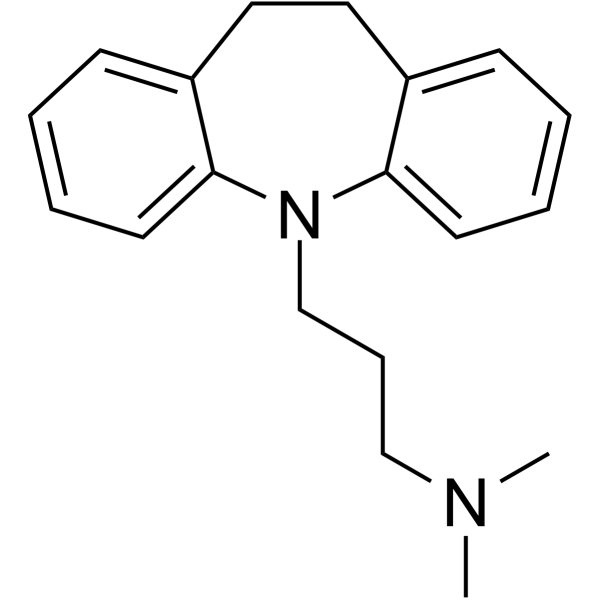上海金畔生物科技有限公司为生命科学和医药研发人员提供生物活性分子抑制剂、激动剂、特异性抑制剂、化合物库、重组蛋白,专注于信号通路和疾病研究领域。
Imipramine (Synonyms: 米帕明)
Imipramine 是一种具有口服活性的叔胺类三环抗抑郁药。Imipramine 是一种具有抗肿瘤活性的 Fascin1 抑制剂。Imipramine 刺激 U-87MG 胶质瘤细胞自噬(autophagy),诱导 HL-60 细胞凋亡(apoptosis)。Imipramine 具有神经保护和免疫调节作用。
Imipramine Chemical Structure
CAS No. : 50-49-7
| 规格 |
|
是否有货 |
|
| 100 mg |
|
询价 |
|
| 250 mg |
|
询价 |
|
| 500 mg |
|
询价 |
|
* Please select Quantity before adding items.
Imipramine 的其他形式现货产品:
Imipramine hydrochloride
| 生物活性 |
Imipramine is an orally active tertiary amine tricyclic antidepressant. Imipramine is a Fascin1 inhibitor with antitumor activities. Imipramine stimulates U-87MG glioma cells autophagy and induces HL-60 cell apoptosis. Imipramine shows neuroprotective and immunomodulatory effects[1][2][3][4].
|
IC50 & Target |
Fascin1, Autophagy, Apoptosis[1][2][3]
|
体外研究
(In Vitro) |
Imipramine (0.5-300 μM, 3 days) inhibits HCT-116 cell viability[1].
Imipramine (20 μM) inhibits cell migration (7 h) and invasion (48 h)[1].
Imipramine (50 μM, 0-240 min) inhibites the PI3K/Akt/mTOR signaling pathway in U-87MG glioma cells[2].
Imipramine (60 μM, 24 h) stimulates U-87MG glioma cells autophagy[2].
Imipramine (80 μM, 24 h) induces HL-60 cell apoptosis[3].
Shanghai Jinpan Biotech Co Ltd has not independently confirmed the accuracy of these methods. They are for reference only.
Cell Viability Assay[1]
| Cell Line: |
DLD-1, HCT-116, and SW-480 |
| Concentration: |
0.5-300 μM |
| Incubation Time: |
3 days |
| Result: |
Inhibited cell viability and HCT-116 was more sensitive than DLD-1 and SW-480. |
Cell Migration Assay [1]
| Cell Line: |
DLD-1, HCT-116, and SW-480 |
| Concentration: |
20 μM |
| Incubation Time: |
7 h |
| Result: |
Produced a remarkable inhibition of migration in all assayed cell lines. |
Cell Invasion Assay[1]
| Cell Line: |
HCT-116 |
| Concentration: |
20 μM |
| Incubation Time: |
48 h |
| Result: |
Inhibited cell invasion through Matrigel. |
Western Blot Analysis[2]
| Cell Line: |
U-87MG |
| Concentration: |
50 μM |
| Incubation Time: |
0, 15, 30, 60, 120 and 240 min |
| Result: |
Markedly inhibited the phosphorylation of both Akt (Ser473) and mTOR (Ser2481) in a time-dependent manner. Also dephosphorylated p70 S6K, a downstream target of mTOR. |
Cell Autophagy Assay[2]
| Cell Line: |
U-87MG |
| Concentration: |
60 μM |
| Incubation Time: |
24 h |
| Result: |
Stimulated the induction of autophagy through the redistribution of LC3 in U-87MG glioma cells. |
Apoptosis Analysis[3]
| Cell Line: |
HL-60 |
| Concentration: |
80 μM |
| Incubation Time: |
24 h |
| Result: |
Induced cell apoptosis. |
|
体内研究
(In Vivo) |
Imipramine (20 mg/kg, i.p. or 15 mg/kg, p.o.; daily for 24 days) attenuates neuroinflammatory signaling and reverses stress-induced social avoidance in mice[4].
Shanghai Jinpan Biotech Co Ltd has not independently confirmed the accuracy of these methods. They are for reference only.
| Animal Model: |
Male C57BL/6 mice (6–8 weeks old) subjected to RSD (repeated social defeat) and HCC (home cage control)[4] |
| Dosage: |
20 mg/kg or 15 mg/kg |
| Administration: |
Intraperitoneal injection or oral administration, daily for 24 days |
| Result: |
Reversed RSD-induced social avoidance behavior, significantly increasing the interaction time, significantly decreased stress-induced mRNA levels for IL-6 in brain microglia. |
|
| 分子量 |
|
| Formula |
|
| CAS 号 |
|
| 中文名称 |
|
| 运输条件 |
Room temperature in continental US; may vary elsewhere.
|
| 储存方式 |
Please store the product under the recommended conditions in the Certificate of Analysis.
|
| 参考文献 |
-
[1]. Alburquerque-González B, et al. New role of the antidepressant imipramine as a Fascin1 inhibitor in colorectal cancer cells. Exp Mol Med. 2020 Feb;52(2):281-292.
[2]. Jeon SH, et al. The tricyclic antidepressant imipramine induces autophagic cell death in U-87MG glioma cells. Biochem Biophys Res Commun. 2011 Sep 23;413(2):311-7.
[3]. Xia Z, et al. The antidepressants imipramine, clomipramine, and citalopram induce apoptosis in human acute myeloid leukemia HL-60 cells via caspase-3 activation. J Biochem Mol Toxicol. 1999;13(6):338-47.
[4]. Ramirez K, et al. Imipramine attenuates neuroinflammatory signaling and reverses stress-induced social avoidance. Brain Behav Immun. 2015 May;46:212-20.
|
所有产品仅用作科学研究或药证申报,我们不为任何个人用途提供产品和服务

